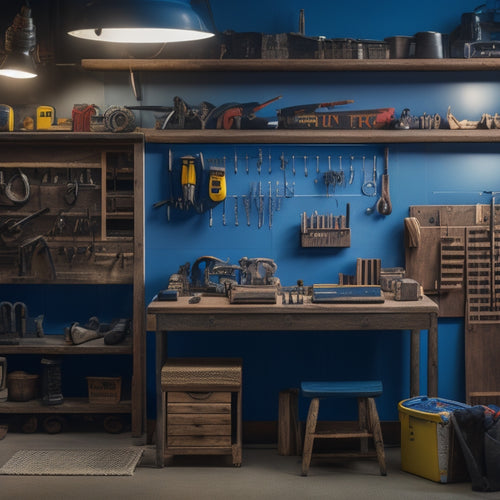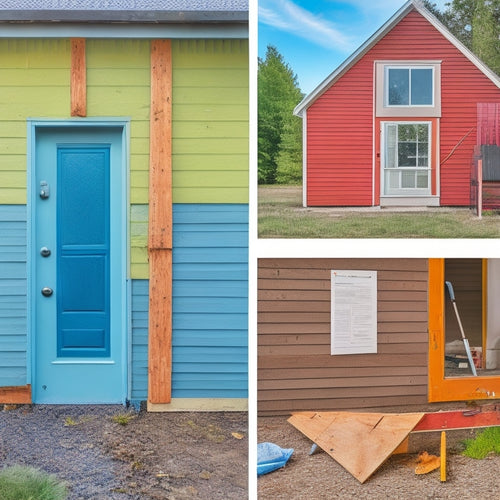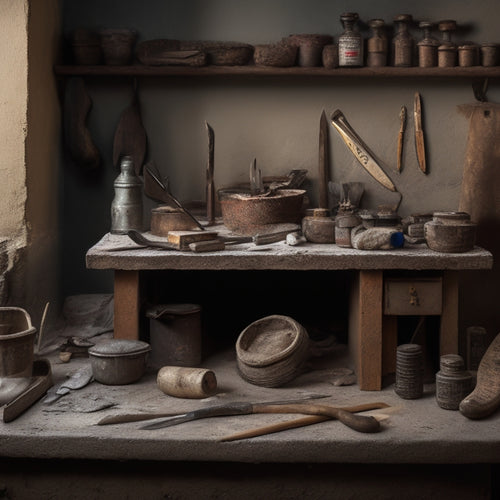
5 Tips for Renting Sander Tools for Renovation
Share
When renting sander tools for your renovation project, you'll want to make the most of your rental experience. First, choose the right sander type for your specific task and surface, considering features like variable speed control and dust collection system. Next, assess your ceiling's plaster condition to identify areas needing repair before sanding. Then, evaluate your project scope to determine the necessary rental duration, and prioritize dust containment and debris management. Finally, inspect tools before renting to guarantee they're in good condition, and you'll be well on your way to a successful renovation. By doing your due diligence, you'll set yourself up for a smooth project that yields professional-grade results.
Key Takeaways
• Choose the right sander type for your project, considering factors like surface type, size, and features like variable speed control and dust collection.
• Inspect your ceiling's plaster condition before sanding to identify areas needing repair, ensuring a safe and successful renovation.
• Evaluate your project's scope to determine the necessary rental duration, and review rental agreements for additional fees or charges.
• Prepare for dust and debris by containing the work area, sealing air vents, and setting up a dust containment system and regular cleanup plan.
• Inspect tools before renting, checking for wear, damage, or malfunction, and understanding operating instructions and safety precautions.
Choosing the Right Sander Type
You'll need to select from a variety of sander types, each suited to specific tasks and surfaces, to achieve ideal results in your renovation project.
Belt sanders, for instance, are perfect for large, flat areas, while orbital sanders are better suited for curved or irregular surfaces. When choosing a sander, consider the sander features that matter most to your project. Do you need variable speed control or a dust collection system? Are you looking for a sander with a high horsepower motor or one that's lightweight and portable?
Research different sander brands, such as Bosch, DeWalt, and Makita, to find the one that best fits your needs and budget. Each brand offers unique features and benefits, so it's important to compare them before making a decision.
Additionally, consider the type of sandpaper or abrasive you'll need for your project. Some sanders may require specific grits or types of sandpaper, so be sure to factor that into your selection.
Assessing Your Ceiling's Plaster Condition
With your sander tool selection complete, it's time to turn your attention to the surface you'll be working on, starting with an assessment of your ceiling's plaster condition to determine the best approach for sanding and renovation.
You'll need to inspect the ceiling for cracks, holes, or water damage that may require plaster repair before sanding. Perform a thorough ceiling inspection, checking for any signs of wear or damage.
Look for cracks, which can be a sign of structural issues, and check for soft spots or sagging areas that may indicate water damage.
Take note of any areas that will require special attention or additional repair work before sanding. This assessment will help you determine the best course of action for your renovation project, ensuring that you're prepared to tackle any challenges that come your way.
Understanding Rental Period Options
When planning your renovation project, determining the rental period for your sander tools is essential to staying on schedule and within budget.
You'll need to evaluate the scope of your project and how long you'll need the tools to complete it. Most rental companies offer flexible rental periods, including daily, weekend, and weekly rates.
Daily rental rates are ideal for small projects or for tasks that require a specific tool for a short period. These rates are usually calculated based on an 8-hour workday, and you'll need to return the tool by the end of the day to avoid additional charges.
If you're working on a larger project that spans over the weekend, look for weekend rental specials. These deals often provide a discounted rate for rentals that start on Friday and return on Monday. This can be a cost-effective option, especially if you're working on a project that requires multiple tools.
Be sure to review the rental agreement carefully and ask about any additional fees or charges before finalizing your rental period.
Preparing for Dust and Debris
Renting the right sander tools is only half the battle; now, it's time to focus on preparing your workspace for the inevitable dust and debris that comes with sanding.
You'll need to prioritize dust containment and debris management to guarantee a safe and efficient renovation process. Start by covering your floors, walls, and furniture with drop cloths or plastic sheets to prevent damage from dust and debris. Seal off any air vents or openings to prevent dust from spreading to other areas of your home.
Consider setting up a dust containment system, which can include a vacuum with a HEPA filter or a dust collection bag attached to your sander. This will help minimize the amount of dust that becomes airborne.
Next, designate a specific area for debris disposal and have a plan in place for regular cleanup. By taking these steps, you'll be able to contain the mess and stay focused on your renovation project.
Inspecting Tools Before Renting
Before taking possession of the sander tools, inspect them carefully for signs of wear, damage, or malfunction, as faulty equipment can compromise the quality of your renovation project and even pose a safety risk.
Check the power cord, plug, and switches for any damage or fraying. Make certain all moving parts are well-lubricated and functioning smoothly. Look for any signs of rust or corrosion on metal components. Test the tool's performance by running it for a few minutes to verify it's vibrating or spinning evenly.
When inspecting the tools, keep in mind the safety precautions outlined in the rental agreements. Confirm you understand the operating instructions and any specific precautions to take when using the equipment.
Don't hesitate to ask the rental staff if you have any questions or concerns. A thorough inspection will help you identify any potential issues before you start your project, saving you time and hassle in the long run.
Frequently Asked Questions
Can I Rent a Sander for a Short Period, Like an Hour?
You're wondering if you can rent a sander for just an hour? The answer is, it depends on the rental provider.
Some offer short-term rentals, but you'll need to check their policies.
Availability of sanders for short-term rentals varies, so it's best to call ahead and confirm.
Be prepared to provide details on your project's scope and timeline to guarantee they can accommodate your needs.
Do Rental Sanders Come With Dust Collection Bags?
As you commence your renovation journey, you're wise to wonder about the dust collection features of rental sanders.
Think of dust as a storm cloud, and a good dust collection system as your trusty umbrella. Not all rental sanders come with dust collection bags, but most orbital and belt sanders do. Some even have vacuum attachments.
When renting, you'll find that different types, like drum or floor sanders, may have varying levels of dust collection capabilities. Be sure to ask about these features when you pick up your rental sander.
Can I Use a Rented Sander on Concrete Floors?
When deciding to use a rented sander on concrete floors, you'll need to take into account the sander type and concrete preparation.
Not all sanders are suitable for concrete, so make sure you rent a concrete-specific sander or a planetary grinder.
Prepare the concrete by cleaning it thoroughly and filling any cracks or holes.
You'll also need to check the sander's specifications to guarantee it can handle the concrete's hardness and your desired finish.
Are Rental Sanders Suitable for Removing Old Paint?
Imagine the satisfaction of stripping away old, worn-out paint to reveal a surface ready for transformation.
When it comes to removing old paint, you'll want to choose the right rental sander for the job.
Look for sanders specifically designed for paint removal, such as orbital or belt sanders.
These types of sanders are more aggressive and effective at breaking down old paint, making them ideal for your project.
Do I Need to Clean the Rented Sander Before Returning It?
When returning a rented sander, you're responsible for ensuring it's clean and in good condition.
Review the rental agreement to understand the cleaning procedures outlined. Typically, you'll need to remove any debris, dust, or residual materials from the sander's surface and components.
Failing to do so may result in additional fees or penalties. Take the time to properly clean the sander to avoid any extra costs and fulfill your rental responsibilities.
Conclusion
You've made it through the rental process and are ready to tackle your renovation project.
Remember, the right sander tool can make all the difference. In fact, according to the National Association of the Remodeling Industry, 64% of homeowners who rent sander tools report a significant reduction in project time and cost.
By following these 5 tips, you'll be well on your way to a successful renovation.
Related Posts
-

7 Smart Tool Organization Tips for Small Renovations
As you tackle your small renovation, you're likely wasting precious time searching for misplaced tools. To enhance ef...
-

Why Exterior Wall Renovation Requires a Plan
You're about to commence a complex and potentially costly project when you decide to renovate your exterior walls, an...
-

Stucco Tool Kit Checklist for Home Renovation
You'll need a thorough stucco tool kit to guarantee a successful home renovation, as the right tools can make all the...


